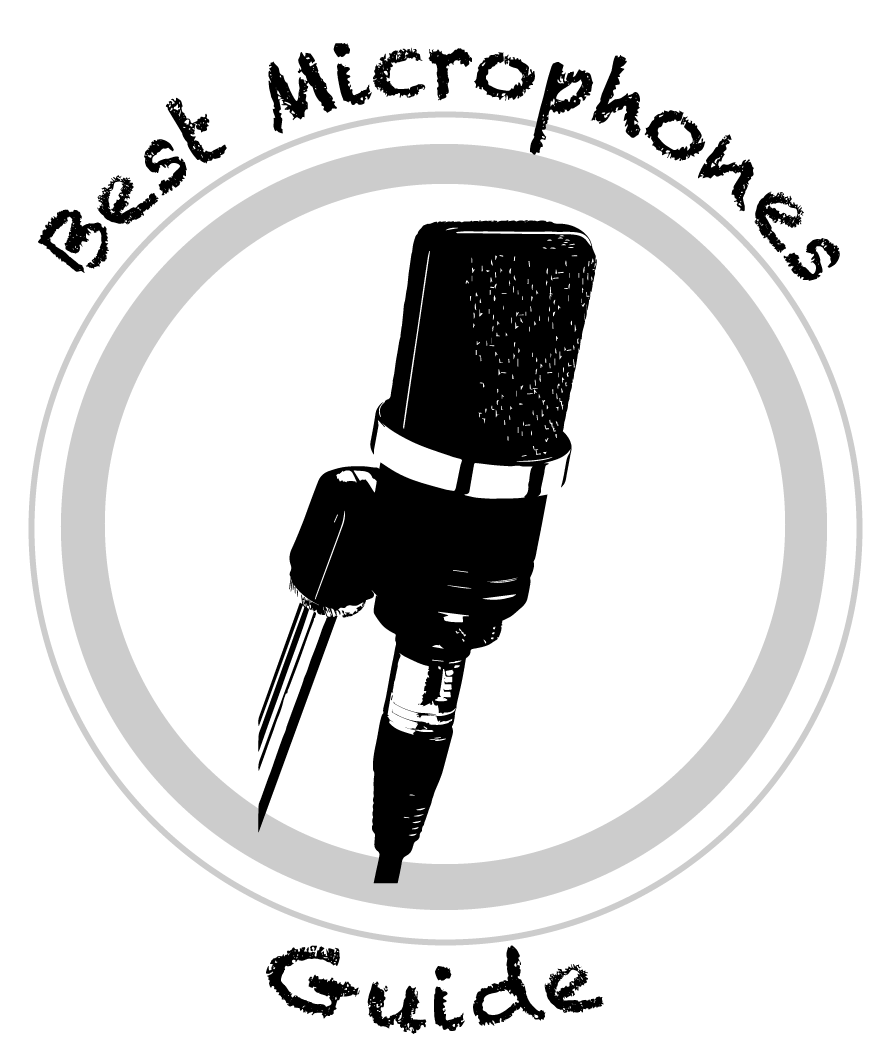Sennheiser e906 Microphone Review
Designed to be a Top Microphone for Electric Guitar
As an Amazon Associate, I earn from qualifying purchases at no additional cost to you.
The Sennheiser e906 microphone is one of the top microphones for electric guitars, both on stage and in the recording studio. This is no surprise, as it was specifically designed to excel at miking electric guitar amplifiers. What you might not know is that the e906 is also a very versatile mic that can be used to record a variety of other instruments such as the snare drum, toms, the acoustic guitar, and brass.
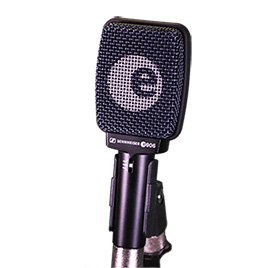
A Brief History of the Sennheiser e906
Let’s begin this review with a little history. The lineage of the e906 can be traced back to the 1960s. At that time, Sennheiser introduced the Sennheiser MD407 microphone. Like the e906, the MD407 was a flat front dynamic microphone that excelled at miking electric guitar amplifiers. Some people call the shape a “lollipop shape.” While the e906 is super-cardioid, the MD407 had a cardioid polar pattern.
The MD407 had the earliest version of the well known MD409 capsule. The version of the capsule in the MD407 was the 402/1 capsule.
Our next microphone in the lineage of the e906 was the aforementioned Sennheiser MD409. This mic was, like the MD407, a flat front dynamic microphone with a cardioid polar pattern. The MD409 utilized a similar capsule to the MD407, the 402/3, a somewhat famous capsule.
In addition to being a top choice for miking guitar amps, the Sennheiser MD409 also did a very nice job on vocals. It was used by David Gilmour as his vocal microphone during the famous 1972 live concert documentary “Pink Floyd: Live at Pompeii.” Here you can see the microphone being used while they perform “Echoes Part I” during the concert.
The Sennheiser MD409, while it was an amazing microphone, was also very expensive to manufacture. Additionally, it was not selling in high enough numbers for Sennheiser to continue making it. And so, sometime during the 1980s, the MD409, which had previously gone through a few variations, was phased out in favor of the similar Blackfire MD509, which eventually was discontinued as well.
Then, in 1998, the evolution microphone series was launched by Sennheiser. The evolution series originally included 3 vocal microphones (the e825, e835, and e845), as well as instrument microphones in the 600 series – the e602, e604, e608, and e609. Sennheiser’s stated goal in launching this series was to “cover the needs of the entire band.”
The Sennheiser e609 (also called the e609 silver) is the microphone in that group that we are interested in as part of this story. Like the other predecessors, it is a flat grill microphone designed to mike electric guitar amplifiers either live or in the studio with the option of hanging the mic down over the front of the amp. Unlike the previous mics, the e609 has a super-cardioid polar pattern. The e609 has a frequency response of 40Hz to 18kHz.
Finally, we come to the Sennheiser e906. In 2003, the 900 series of evolution microphones was launched, initially with vocal microphones. Then, in 2004, the series was expanded to include instrument microphones. At this time, the e906 was launched, as well as the e901, e902, e904, e905, e908, and e914 instrument mics.
Meanwhile, the 600 and 800 series mics that had previously been released were re-branded as the “entry level” line with the new 900 series being now considered the higher end microphones. The branding for the e906 is “guitar amp dynamic microphone” with “studio, live, and recording” uses.
Now that we have covered the history of the mic, let’s get onto the next part of our Sennheiser e906 review: its features.
Notable Features of the Sennheiser e906
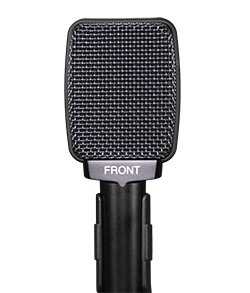
The Sennheiser e906 is a dynamic XLR microphone with a super-cardioid polar pattern. It has a frequency response of 40Hz to 18kHz. It is considered an instrument microphone and one which was specifically designed to excel at miking electric guitar amplifiers.
Sennheiser also promotes it as being excellent for percussion and horns.
The microphone has a very solid feel to it, with a metal body and metal mesh grille. Its grille is fairly sturdy.
The mic has a 3-way presence switch on the back, which is one of its most distinctive features. A presence switch is a more common feature on vocal microphones. It is relatively uncommon for dynamic instrument mics, so this is definitely a selling point.
In the standard position, the switch has a flat response allowing the mic to capture a natural sound that is true to life.
Its other 2 settings allow you to customize your sound. The presence boost setting provides more of a bright sound. Its high frequency cut setting provides a darker sound. The presence switch can also be called an “EQ switch.”
In looking at the frequency response graphs, the difference between the 3 switch settings begins around 2000kHz, is most pronounced around 4200kHz, and is effectively over around 10000kHz.
Note: You will need something like a pencil or flathead screwdriver to change the setting, which is not ideal but is easy enough to do.
Like its predecessors, the evolution 906 has a flat front design which makes it easy to hang over a guitar amp. This, of course, also means that you do not need a microphone stand for the mic when miking electric guitar amps. You will, of course, have some added flexibility for positioning the mic if you do use a mic stand.
The Sennheiser e906 is a Top Microphone for Recording Electric Guitar
We tested many of the top guitars commonly used for recording electric guitar. The evolution 906 performed so well in our testing that we ranked it very highly on our list of Best Microphones for Recording Electric Guitar. In fact, only the significantly more expensive Sennheiser MD421-II ranked more highly on our list.
For capturing distorted electric guitar sounds, the e906 performed very strongly. It recorded a big, in your face sound when playing hard rock chords. It also handled muting nicely, providing excellent detail for individual notes as well as chords. Lead guitar tones came through sounding amazing as well. Across the board, this is a great mic for recording hard rock electric guitar.
In terms of clean electric guitar, the e906 did not sound as good as the MD421-II when strumming. The low end was fairly prominent in a way that didn’t sound quite as good. However, this was with the presence switch set to normal, and could be mitigated by putting the presence boost on.
That said, for recording clean arpeggios or other single notes, we gave this mic our top rating. It really stood out, producing full and rich sounding clean tones. In this category, we actually felt there was a wide gap between the e906 and the next mic. Interestingly, it may have been the additional bass tones which did not sound great for strummed chords which made individual notes pop with a more full, rich sound.
We highly recommend the Sennheiser e906 for recording electric guitar.
The Sennheiser e906 is Excellent for Live Electric Guitar Performance
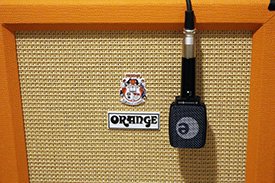
The e906 checks off lots of boxes on the wish list for road-ready microphones. Its rugged and sturdy construction means that it will be able to withstand the rigors of the road and live performance.
The microphone can handle high sound pressure levels (SPLs), a necessity for the stage.
Its super-cardioid polar pattern allows it to very specifically pick up the sound of the guitar amp while minimizing bleed and rejecting sound from other on stage sound sources.
Its flat front design is especially convenient on stage with the ability to use one less mic stand and hang the mic over the front of the amplifier.
The microphone provides the same top sound quality for live performances as it does in a recording studio.
The e906 is a Very Good Acoustic Guitar Microphone
Sennheiser does not promote the evolution 906 as a microphone for acoustic guitar, but maybe they should. Why? Because the e906 is a surprisingly good microphone to record acoustic guitar with. In our video below, you will see that it held its own against the Shure SM57, a mic which is often considered a top choice to record acoustic guitar with.
For strummed chords, the e906 provides a bright, vibrant, and lively sound which was clear and pleasant to the ear. It is capable of delivering a beautiful, light, rich, and warm sound for single notes and arpeggios.
On acoustic guitar, it seems to work best with either the flat / normal presence setting or the presence boost setting.
Its ability to record acoustic guitar is not its #1 strength, but it is another feather in its cap. Recording acoustic guitar is another way you can utilize this very versatile mic.
Check out our video demonstration of recording acoustic guitar with the Sennheiser e906:
Using the e906 with Drums and Other Instruments
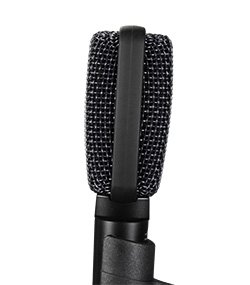
Sennheiser markets the e 906 as being “excellent” for both percussion and horns.
We have tested the mic for recording snare drum and toms. It sounds quite good for snare and toms. Moreover, the 3 way switch provides additional sonic versatility to shape the sound that you don’t usually get with drum mics. You can definitely use these switches to get a snare drum sound that really cuts through the mix and stands out.
It took a little getting used to positioning the microphone to mic drums due to the flat front shape.
Overall, we found the mic to be competitive with other top microphones that are commonly used for recording snare drums and toms.
Sennheiser also mentions on their web site that it can be used to mic kick drums as well. We have not tried it but it seems like it would make for an interesting mic to place in front of the kick drum (not inside.)
Here is our video demonstration of recording snare drum and toms using the e906:
Does the Sennheiser e906 Need Phantom Power?
A common question about almost any microphone is: does it need phantom power? As the Sennheiser e906 is not a dynamic microphone, it does not require phantom power. Unlike condenser microphones, dynamic mics do not need phantom power.
Sennheiser e906 vs. Sennheiser e609 Comparison
As part of this Sennheiser e906 review, we will take a look at one specific microphone comparison. Namely, how does it stack up vs. its “little brother,” the e609. Many people wonder how these 2 similar microphones compare. As mentioned earlier, Sennheiser now markets the evolution 600 series as their “entry level” microphones. The 900 series is considered to be higher end microphones.
Primary Difference #1:
The first main difference between the Sennheiser evolution 609 and the evolution 906 is the frequency response range. There are 1 or 2 retailers that are quoting the e609 frequency response number inaccurately at the moment, but most have it correct. The correct number (as per Sennheiser) for the e609’s frequency response is 40Hz to 15kHz. The e906’s frequency response is wider at the top: 40Hz to 18kHz.
Primary Difference #2:
A second main difference between the e609 and e906 is that the e609 does not have any settings to adjust the sound of the microphone. As we know, the e906 has the 3 way EQ switch allowing you to customize the sound to your liking. Sennheiser states on their web site that the addition of the 3 way switch is the biggest upgrade they made to the e609.
Primary Difference #3:
A third main difference between the e609 and e906 is that the body of the e906 was enhanced to make it more rugged. Sennheiser says that the upgraded metal body of the e906 is designed to be even more durable for live performance usage and travel.
Primary Difference #4:
The fourth primary difference between the e609 and e906 is that the e906 has a flatter frequency response. Sennheiser received feedback regarding the e609 that some customers found its high end to be “harsh” and “unforgiving.” They have modified the e906 to have a flatter, natural response with no added coloration.
Price Point Comparison:
Usually, the e906 sells for about double the price as the e609. Let’s talk about another price point to consider and take note of depending on what your goal is. Namely, the Shure SM57, also a great microphone for miking guitar amps is around the same price as the e609.
e609 vs e906 Sound Comparison:
There is a range of opinion on the two microphones and the price difference has to be factored in as well.
There is no question that the e906 is the higher end and better sounding microphone. It is a smoother sounding microphone which also provides more clarity. The 3 way switch allows you to customize the sound to your liking which is a big advantage. The difference in sound is perhaps a bit less pronounced on clean sounds and more noticeable on distorted guitar.
Now, one other point of interest worth noting is from another group of people. Namely people who have used the predecessors of the two mics such as the MD409 (We have not). Many of these people have strong opinions that they have voiced in online audio and equipment forums.
The overall gist of these opinions is that Sennheiser tried to replace a high priced, high quality microphone, the MD409 (and also the Blackfire 509) that was expensive to manufacture, with the much lower end, much cheaper model the e609. With the reference point of the MD409, many of these people state very negative opinions of the e609.
Many of the same people in these forums had a much better opinion of the e906, which came out later than the e609. These opinions were varied but could be summarized as follows: 1) its very similar in sound to the MD409 2) its not as good as the MD409, but is somewhere in the ballpark 3) one of the three settings sounds very similar to the MD409 4) it doesn’t sound like the MD409, but is a very good mic.
Final Thoughts on the e906 vs e609:
So the key question would be is the e906 worth $100 more than the e609? That is something that depends on your budget and your goals. If your intent is primarily live use, then perhaps the e609 is a better choice at that price point. If the intent is both recording and live use, and you can afford the better mic, then the e906 may be the best choice for you. You can add it to your mic locker and use for many years.
Some people may also consider buying one of these mics to get a different guitar sound than they get with their current mics. If so, you might be purely deciding between e609 vs e906.
However, if you are looking for your first microphone to mic a guitar amp and are on a budget, then there is another option. You might instead make the decision between the SM57 and the e609. Both are around the same price.
Conclusion for Sennheiser e906 Mic Review
The Sennheiser e906 is a microphone that we highly recommend for miking electric guitar amps, both for recording and on stage use. If you can afford the extra $100 and plan to use it for recording, it is definitely a better microphone than the e609. As an added bonus, it has additional versatility to record acoustic guitars (where it is underrated), drums, percussion, and even brass.
Additional Resources
Sennheiser Information Page for the e906
